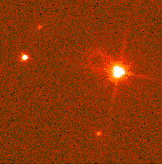Beyond the Heliosphere
Introduction
Probably the least anticipated discoveries of Ulysses have been those of phenomena occurring beyond the heliosphere. Ulysses has launched the exploration of our immediate interstellar neighborhood with the first measurements of interstellar neutral He and pickup ions, including the cosmologically important 3He. Ulysses has detected interstellar dust, and examined its properties. The unique orbit of Ulysses has enabled studies of gamma-ray bursts that otherwise would not have been possible, and played a major role in discovering soft gamma repeaters, or 'magnetars'.
Gas in Local Interstellar Medium - Implications for Galactic Evolution and Cosmology
Measurements by the Ulysses GAS experiment of interstellar helium atoms have provided the most accurate determination of the velocity of the Sun with respect to the local interstellar medium (26 kms-1) and of the temperature of the local interstellar gas (6500 K).
 |
|
The Sun and the nearest stars move through filaments of galactic clouds (Copyright P. C. Frisch, University of Chicago). |
Interstellar pickup ions measured by the SWICS experiment on Ulysses are being used to deduce the density and degree of ionization of the gas in the Local Interstellar Cloud (LIC) surrounding the heliosphere.
Ulysses SWICS data have been used to study the composition of elements in the LIC. It seems that the heavy elements Nitrogen and Oxygen in the present-day LIC are under-abundant compared with their abundance in the protosolar cloud. This is just the opposite of expectations. Galactic evolution over the last 4.6 billion years should have enriched the abundance of heavy elements in the LIC gas compared to that in the protosolar cloud. On the other hand, the abundance of neon in the LIC measured by Ulysses appears to be equal to or even higher than its solar abundance, which would be more consistent with expectation.
Size Distribution and Dynamics of Interstellar Dust in the Planetary System
Analysis of interstellar dust grains inside the heliosphere, a key Ulysses discovery, provides a new window for the study of diffuse interstellar matter. Ulysses discovered dust particles to be more massive (> 10-13 g) and found smaller grains to be less abundant than the 'classical' interstellar grains that are observed by astronomical means. Calculations show that, depending on the polarity of heliospheric magnetic field (HMF), 0.1 μm-sized and smaller particles have great difficulty entering the heliosphere owing to their interaction with the HMF. The solar magnetic polarity reversal in 2001-2002 was expected to affect the distribution and properties of interstellar dust in the heliosphere, concentrating the dust toward the Sun and into the inner heliosphere. Observations by Ulysses in this period have proven this to be correct (see also "Ulysses sees Galactic Dust on the rise").
Gamma-Ray Bursts
 |
|
Hubble Space Telescope image of the galaxy where the gamma-ray burst of 1 March 2000 originated. This burst came from a distance of 11 billion light-years. Ulysses and the Rossi X-Ray Timing Explorer determined its position. |
In the course of studying gamma-ray bursts, Ulysses has played a major role in the study of so-called soft gamma repeaters, or 'magnetars'. These are neutron stars in our own galaxy, which are thought to possess magnetic fields with strengths of >1014 G. They are especially interesting as cosmic laboratories where the behaviour of matter and its associated radiation can be studied under extreme conditions. Magnetars occasionally emit giant flares that produce the strongest X-ray fluxes ever measured at Earth from an extra-solar object. One such event, observed by Ulysses on 27 August 1998, was so intense that it produced a major ionospheric disturbance.
